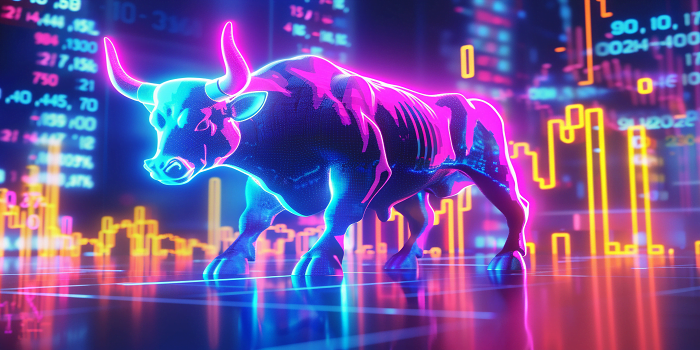Bull Market: A Guide to Understanding and Thriving in Rising Markets
A Bull Market is a time when stock prices are rising or expected to rise. This optimism leads to increased buying, pushing prices even higher. Bull Market can also happen in other markets like real estate, bonds, and commodities. They often signal a strong economy with growing businesses and low unemployment.
What Defines a Bull Market?
A bull run is typically defined by an increase of 20% or more in stock prices after a previous decline of 20% or more. However, this percentage isn’t set in stone—what truly defines a bull run is sustained upward momentum driven by strong economic factors. Some characteristics that define a bull run include:
- Rising stock prices over an extended period
- High investor confidence in the economy and market
- Increased corporate profits driving the market higher
- Low unemployment and overall economic growth
- High demand for stocks and other assets, with more buyers than sellers
When these factors align, they create a bullish environment where both individual and institutional investors feel confident about the future.
How Long Does a Bull Market Last?
The duration of a bull run can vary significantly. Historically, bull run have lasted anywhere from a few months to over a decade. The longest bull run in history (American Bull Run) occurred after the 2008 financial crisis, lasting over 11 years from 2009 to 2020, when it was interrupted by the COVID-19 pandemic.
While bull runs can be long and profitable, they don’t last forever. They are often followed by bear markets (periods of declining prices), which can be triggered by economic downturns, rising inflation, or geopolitical events.
In India Context
In the Indian context, bull run have historically lasted anywhere from a few years to over a decade For instance, the bull run that began in 2003 and ended in 2008 was relatively long-lasting, fueled by India’s robust economic growth and favorable global conditions. However, the market crash of 2008 brought this bull run to an abrupt end. Currently, India’s stock market is experiencing a period of sustained growth, but predicting its longevity remains challenging
What Sectors Thrive in a Bull Market?
Different sectors of the economy perform better than others during a bull run. Investors often see specific industries thriving due to increased consumer confidence and spending. The following sectors typically perform well during a bull run:
- Technology – The tech sector tends to lead in a bull run, as innovation and growth opportunities attract investors. Companies like Apple, Microsoft, and Tesla often see their stock prices rise significantly.
- Consumer Discretionary – As consumer confidence increases, so does spending on non-essential goods like luxury items, travel, and entertainment. Retailers, restaurants, and leisure companies often benefit from this uptick.
- Financial Services – Financial institutions like banks and investment firms tend to profit during bull run as more people borrow money and invest in growing markets.
- Industrial and Manufacturing – As the economy expands, businesses invest in infrastructure, increasing demand for materials, machinery, and equipment, driving up stock prices in this sector.
- Energy – Growing economies require more energy, and demand for oil, natural gas, and renewable energy sources tends to increase in bull markets
How to Recognize the End of a Bull Market
While it’s difficult to predict the exact end of a bull run, there are some indicators that can help investors recognize when the market might be turning. These signs include
- Economic Slowdown
- If key economic indicators like GDP growth, employment rates, and corporate profits begin to slow, it could signal the end of a bull run.
- Rising Interest Rates
- Central banks often raise interest rates to control inflation during periods of economic growth. Higher rates can reduce consumer spending and corporate earnings, leading to lower stock prices.
- Excessive Valuations
- If stock prices have risen significantly and are trading at much higher valuations compared to their earnings, it could indicate that the market is overheating and due for a correction.
- Shift in Investor Sentiment
- If investors start pulling money out of the stock market and moving it into safer assets like bonds or gold, it may suggest the beginning of a bear market.
Impact of a Bull Market on Investor Behavior
Rising prices and optimism lead to larger bets and investments in riskier assets. This can inflate prices as people follow trends without considering fundamentals. While many benefit, overconfidence can lead to poor decisions and losses when the market corrects.
Importance of a Bull Market
Rising prices signal prosperity with increased employment, profits, and consumer confidence. They offer wealth creation opportunities for early investors. Bull run encourage more companies to go public, providing capital for growth and stimulating the economy.
Top 3 Sectors to Watch
The Indian bull market presents a plethora of opportunities for investors. To capitalize on this growth, it’s crucial to identify sectors poised for significant expansion. This section will delve into the top 3 sectors that are expected to thrive during the Indian bull run, providing valuable insights for investors seeking to maximize their returns
- Technology
- Healthcare
- Infrastructure
Note: 'Bull Run' and 'Bull Market' are used interchangeably in this article.Bull Market make everyone look like a genius.
